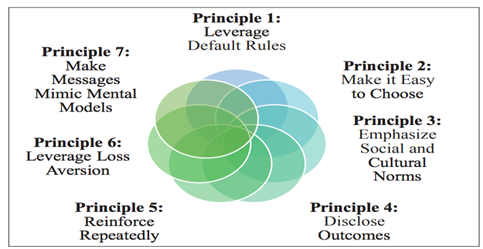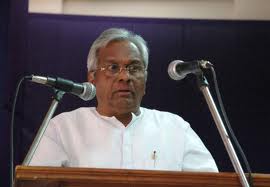P Victor Vijay Kumar
Ms. Nirmala Sitharaman has presented the first budget of the new government with the same old theme of verbosity and pompousness. Let’s look at a few of the things this exercise has clearly disclosed (for better readability and comprehension, the author has limited his analysis to only certain glaring aspects).
Demons speaking human language
The Economic Survey, which preceded the budget presentation, presented the following pictorial representation of behavioural economics:

Not one principle of the touted behavioural economics the survey boasted of was considered during the time of demonetisation. No one needs special education to understand that demonetisation was just a despotic measure and had nothing to do with any behavioural economics principles i.e, neither was it concerned about disclosed outcomes, nor about making it easy to choose, nor empathising with any social norm, nor with repeated reinforcement etc.
Flow of verbosity
The budget backed Economic Survey comes with “Blue Sky Thinking”, “Anglo-Saxon thinking” etc. The survey claims to have adopted a unique approach and come up with unique findings without offering any concrete, pinpointed unique finding it has formulated, in comparison with past surveys. When it has nothing special offer by way of findings, there is no case to bring in all the extra jargon into the report. This entire report remains a communication gimmick. While numerous Economic Surveys had been conducted by various governments in the past, and none of them can ever be assessed as being coloured by the ruling government’s ideas, in this budget this verbosity is rampant and excessive. This has made the Economic Survey a political agenda driven survey adorned with a lot of paint and structured as a play of jargon in English. It never spoke about the kind of bizarre unemployment findings the NSSO brought out, nor was it able to find out what kind of impact GST and demonetisation had on India and how people lost various opportunities and, if possible, whether the same can be restored or not.
There was no great expectation of objectivity in the Economic Survey from this Government but this survey shows how the very sanctity of Economic Survey findings is fast deteriorating. What is notable is that some of the surveys done during the Congress time had at least some commentary about corruption, its causes and repercussions, while actually Congress was dethroned on the charges of heavy corruption. The Economic Survey funnily notes Prime Minister’s quote, “if everyone of the 130 crore Indians takes one step forward, the country will go that many steps ahead”. Now it is up to you to laugh at yourself, to see how this silly statement is quoted as a visionary statement in the Indian Economic Survey.
Torn curtain in backdrop
We must understand the woes of the economic system, especially those that occurred in the past 3-5 years.
• The Gross Capital Formation (investment in new capacities/projects) has come down from 34.3% in 2014 to 31% in 2018. That is quite a drop of new investments, as it is normally supposed to post at least a minimal growth relative to our economic needs.
• Both the rural and urban unemployment rate is highest in the past 45 years.
• Farmer suicides have become a norm of social life.
• Exports have fallen from 25.4% in 2014 to 19.7% in 2019.
• Rs. 10 lakh crore of Gross NPAs have resulted in a sagging banking system.
• Unprecedented liquidity crunch in NBFCs.
• Falling auto sales by 10-15%.
• Latest figures show near stagnant growth in IIP index (Index of Industrial Production).
• There is a remarkable fall in domestic savings, from 34.6% in 2012 to 30.5%.
• Falling consumer spending, as top 4 FMCG companies in India have already reported sluggish growth in their sales.
While this being so, the trade war between China and the US is making international economy jittery in, the threat of war from North Korea is alarming, the US sanctions on Iran, elimination of MFN status for India by the US, slowing global economy, falling rupee, rising crude prices do need to be brought out and be given an open thought, from Indian economic perspective elaborately. This is woefully missing in the Economic Survey.
The fact remains that all is not well in the economy. If the Government does not want to raise red flags, it is ok, but certain conspicuously evident findings cannot be hushed up, at the very least, especially looking at the bombastic promises the Government has made to the people of India.
Masqueraded figures
While we see that this whole Economic Survey and Budget remains a communication gimmick, it also played with intricacies of figures. The gross NPAs of banks are north of Rs. 10 lakh crore while the budget says already Rs. 4 lakh crore of assets have been recovered from NCLT. The straight recovery of 4 lakh crore would have resulted in direct bottom line improvement by Rs. 4 lakh crore by now, whereas banks like PNB are posting losses.
Bank recapitalisation – a scare
In the last 10 years, about Rs. 2.6 lakh crore of capital was infused into the banking system by the government for recapitalisation to fall in line with Basel III norms. While Gross NPAs have risen nearly fourfold in the past 5 years, the provision for recapitalisation is only Rs. 70,000 crore which will only force banks to stay in status quo and follow indifferent business practices. There is no clue how the credit growth is going to be boosted and how it is going to stimulate further investments in infrastructure, while the budget keeps talking about several ‘Bharat Mala’ and ‘Sagar Mala’ sort of mega projects.
PSU Disinvestment – digressive point
The Government set an aggressive target of Rs. 1.05 lakh crore in disinvestment in uncertain capital market conditions. The government has relaxed its stand on holding 51% of its holdings in PSUs by including the holdings of government’s undertakings too in respective entities. We do not expect any commitment on government’s stand to hold its interest in PSUs. However, the need of the hour is to ensure viability of mammoth entities like BSNL, Air India kind of PSUs which do not find any mention of the budget and lakhs of Government employees’ future remains in astrology maps.
Revenue increase and debt raising – concern on future leverage
In these grim economic conditions, the Government expects to obtain revenue receipts of Rs. 24.5 lakh crore as against Rs. 21.4 lakh crore in 2018-19, which is nearly a 15% increase. The government talks about Rs. 100 lakh crore investment in infrastructure in next 5 years and it is not sure even if these ambitious figures will help it reach its target. government hints at raising more borrowings citing developed economies’ dependence on large scale debt compared to their GDP (India’s external debt is 5% of its GDP while that of US is 115%). The fact forgotten before talking of leveraging the economy with debt is the income earning ability of the economy which is denoted through its per capita income and our per capita income is 20-30 times below that of these developed countries. However, it is imminent that India would raise more debt than any normal levels in history as the slowing down economy and aggressive infrastructure spending coupled with various no-fruit yielding welfare schemes keep putting pressure on the exchequer. Though depending on debt is not a bad practice, considering debt as one main fund raising source would put India in undue insecure conditions moving forward as the Indian economy and global economy, as well, are not growing encouragingly.
5 trillion dollar economy magic
The government again talks about a pompous vision of achieving a benchmark of 5 trillion dollar economy status by 2025 i.e. in next 6 years. First of all, India growing to 5 trillion dollars in next 6 years would not really help the way it is presumed to wipe out poverty, as much of the income generation is pocketed by top 10-15% of the population as India remains one of the most skewed economies in terms of income distribution. This is not expected to eliminate poverty or reduce unemployment rate by any magic number. The asterisk marks to be noted are – this is not real GDP but this is nominal GDP – which means it factors in inflation rate too. Even to achieve this the economy must grow @14% and this does not look practical. To put it in simple terms, there is no road map towards this except talk about it at a theoretical level.
No productive welfare schemes
There are no productive welfare schemes spelt out in this budget except that it broaches the record of the “Mudra Scheme’, which is a failure, practically. Ayushman Bhava scheme is also not yielding the expected results, due to its own lacunae in deciding eligibility and making it available at the ground level. There is no single scheme which talks about how to improve agriculture production and reduce farmers’ suicides.
There are certain insignificantly or routinely good things in budget like the FAME scheme, declaration of incentives for purchase of electric vehicles, ‘one nation-one grid’, faceless E-assessment, angel tax removal etc. These are all just incremental requirements and nothing dramatic about the same as the government has promised.
Concept is not vision
The Modi government sticks to the same approach of pomposity and verbosity added with abstract expressions and thematic stories of growth. We fail to understand how the following vision that was stated during the budget speech can be achieved.

Still, the government seems to be patronizing people by coining concepts and terming them as visions. A vision is one which needs a concrete back up plan with several alternative ways in mind to achieve the same. This Budget has only concepts, jargon, abstract declarations and uneven figures….nothing really to be excited about.
~~~
P Victor Vijay Kumar is an investment banker and can be reached at facebook id ‘P V Vijay Kumar’ or at his mail id: pvvkumar@yahoo.co.uk










